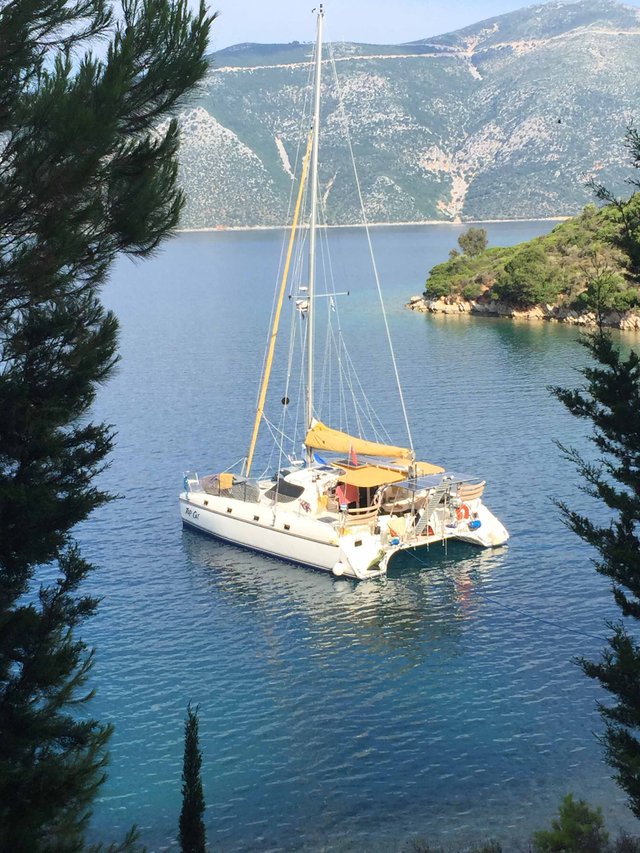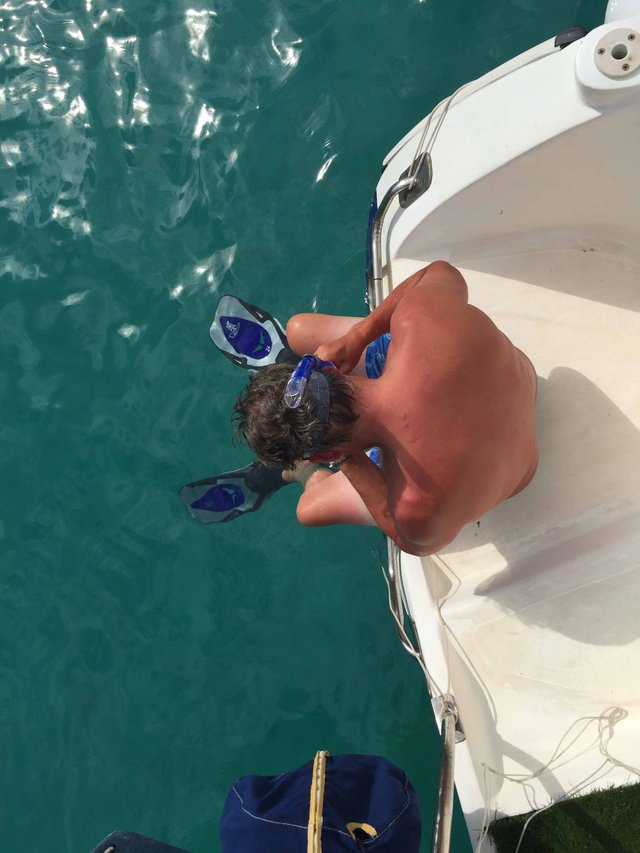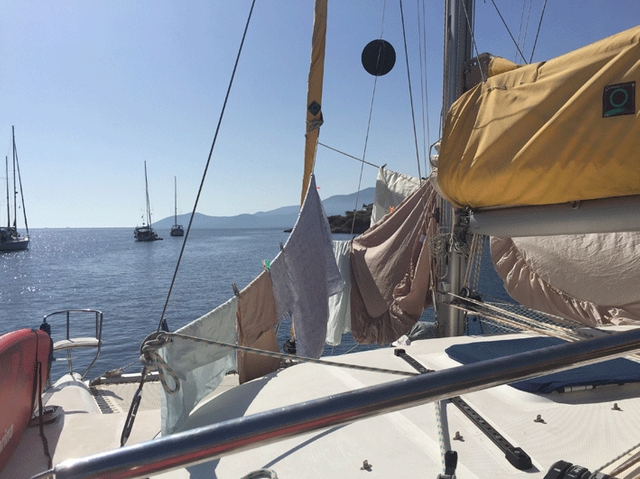Hanging by a thread
Hanging by a thread!
We have spent most of our life so far at anchor. We love being at anchor. Here are my main reasons to prefer the anchor to being alongside a quay.

The breeze …. It is bigger and better out at sea. (In a town the hot pavement makes the air hot and if there is no breeze it is so much hotter in town.
The space …. You know that the next boat is not going to be closer than 40m (except in Lakka when the anchoring was extremely close but it is worth it because it is so beautifully turquoise (except when you anchor with long lines out and the boat next door has a dragging anchor).
The swimming …. You can just jump in the water at any time of day (or night)

The clothes …. No one can see what you are wearing/or not wearing
You can fish easily
Snorkelling …. Good exercise .... Fantastic relaxation
So many bays to choose from
No cost …. You can anchor for free … being alongside costs money. If you are not charged for the town quay you usually end up spending money in the town!
It is not embarrassing having your laundry out to dry. I still get embarrassed when in a town.

The water is much clearer, cleaner and fresher. At Anchor the visibility is often much better because you are on sand rather than mud.
When at anchor, you need to allow enough room all around you as the wind changes direction. You generally put 4 or 5 times the amount of chain down to the depth of water you are in. So if in 5m of water you put down 20m of chain. So you need a 20m radius all around you of safe water where you wont hit any rocks or other boats. The weight of the chain helps to hold you but if the anchor drags you will move fairly quickly. The first you realise you are very close to rocks or have hit another boat. Your anchor is your life line. You are literally hanging by a thread!
All this said, we have found our anchoring to be a lot less stress than being tied stern to on a town quay or in a marina. Even if you do everything right, the boat coming in next door is a potential hazard, I seriously think we need to reconsider our fenders just to protect ourselves from other people.
Having been at anchor for 4 weeks, we had been able to see the anchor on several occasions when in crystal clear waters. Each time we could do this, we noticed our anchor was lying on its side with only one side dug into the sand.
A big source of help for us has been the ‘Women that sail the med’ FaceBook group. I can ask them a question and they come back with answers having been at the coal face so to speak. They are an extremely knowledgeable group and they don't try to baffle you with science.
I had previously asked them what to bring and what not to bring to the Med, I had asked them about money and phones and internet and we had had some great information that we had acted upon. I had topped up my spice supply, bought a paddle board in the UK, and left behind a lot of unnecessary clothing. But it was the anchor advice that was the most useful for us.
It was a no brainer for us to purchase a new anchor, the group referred to the Rocna as the ‘sleep well’ anchor, and I can understand that. When you are at anchor, your whole house and indeed your life is all hanging on whether or not the anchor holds. You want to be able to trust it.
We had been so lucky in that all of our sailing so far had been in minimal to no wind whatsoever. The scariest moments were coming into a harbour or town quay when the anchor had to hold you away from the wall. If we had had big winds we may not have got away so lightly.
Another big lesson learned. If you want to learn about your life on a thread … watch the Rona video … amazing engineering.
Oh I am counting the days (and nights) for my new Rocna!

Thanks for including this video, since I am looking for a better anchor for some time now a Rocna seems to be a interesting one.
Let's print out the drawings from their website and see how (and if) such a thing would fit on my boat...
PS: @tobixen if you read this: We had a talk some time ago about the Rocna. I thought a Rocna is the one like the Rocna, but with a flat blade. Seems that you ment these ones, and I was talking about a slighly different one (is it calles bow anchor in english?).
I think the Bügel anchor has a flat blade and is popular among Germans, but does not perform as good as the Rocna, Spade, Mantus etc.
We have it fitted now ... very pleased so far!
I have an oversized Mantus anchor, same concept, and I sleep very well at anchor.
The "less hazzle" is really one of the biggest advantages in my opinion. We can sail for as long as we want, look at the map to find a nice place to drop anchor, and then it takes just some few minutes until we're set. No stress, can most often handle it very well alone without help.
Coming to some unknown harbour in the late night, not knowing if there will be space or not, perhaps having to do complex operations (like dropping the anchor at some exact place) perhaps in the darkness and perhaps while being deadly tired ... uff.
By anchor I can also get the anchor up quickly and without help and start sailing in the early morning while everyone is still sleeping. Leaving a harbour may be a more complex operation.
Of course, not all places are suitable for anchoring. West coast of Denmark for instance - few places to seek shelter except for in the harbours.
This summer we're trying to manage without the anchor as we have some problems with the anchoring equipment. We originally thought of going to Stockholm, but thought Amsterdam would be better when not having the anchoring gear working
it certainly makes a difference having equipment you are confident with.
Yes anchorage is the best way to live on sea. I love it too.
Here are two more things we've experienced while visiting guest harbours:
Insects. Ok, we've met insects quite far from land as well, but the risk of getting stung by a mosquito is significantly lower when starying by anchor some hundreds of metres from land than when staying by land.
Spiders - they seem to enjoy staying at marinas, and they don't mind jumping on board joining for a sailing trip. We've had quite many spiders on board this season. The webs may be charming to look at, and it's nice to think that the spiders may help to reduce the insect problem - but the latter is insignificant, and there is nothing charming with inadvertently putting the face right into a spider web with a giant spider. Also, quite some of the crew has a bit of a fobia against spiders.
While I've never experienced rats nor mice onboard, I believe the risk is insignificant when staying by anchor.